The team in The Works are pressing on with the overhaul of Sir Nigel Gresley. Locomotive Engineer Darrin Crone provides us with an insight into recent weeks’ work.
Week commencing 14 March 2016
This week saw the completion of the removal of all the tube ends. The last to be removed were the stubs of the small tubes in the copper firebox tubeplate. With the boiler now empty it was given a clean out. As we are now finished climbing in and out of the firebox the temporary working platform was removed. The platform has made the job of working in the firebox so much easier as it must have saved us hours in scrabbling across the grate and retrieving dropped tools that would otherwise end up in the ashpan.
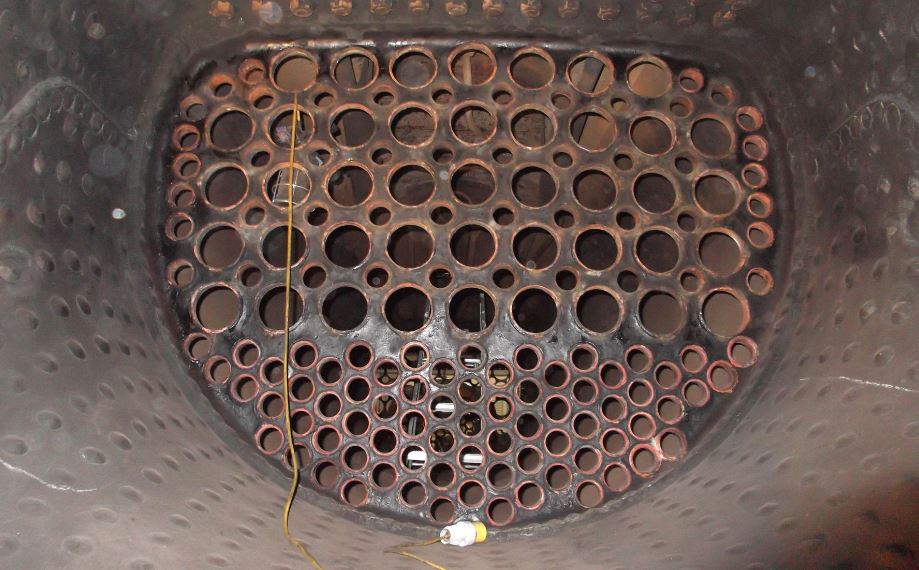
With the firebox platform removed the grate bearer beams were removed and the ashpan was thoroughly cleaned out. While our Chief Mechanical Engineer was on site he checked round the boiler to ensure that it was ready for lifting and that nothing had been missed that could hold down the boiler or snag during the lift.
The only work we now plan to carry out on the boiler will be the removal of the bottom “man hole” door. We plan to wait until the boiler is off the frames for this as to do it on the frames is possible but it would have to be done in a very confined space just inches above the rear vacuum cylinder.
Earlier in the week the removal of the drain cock operating mechanism was completed. All drain cocks have been removed with front pully, rods and links. As the A4 has the centre cylinder set behind and above the outside cylinders the mechanism is much more complicated than a 2 cylinder locomotive.
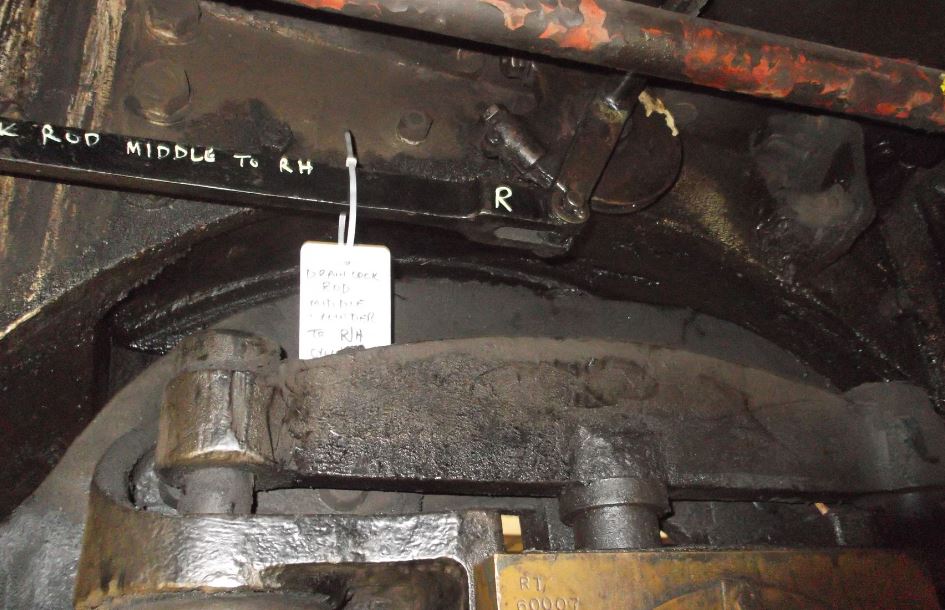
Week commencing 21 March 2016
At the beginning of this week the boiler was ready for lifting so we did a bit of tidying up around the loco and making sure we had everything in place for the lift. Late on Wednesday we were shunted into the North Yard. Not an easy move to make as the museum was in the middle of setting up the Flying Scotsman exhibition and there was stock everywhere.
Next morning we were shunted into the car park which was to be the lift site, then the boiler wagon was shunted on to us. We moved tools to the car park and brought round the large slings from the workshop. The lifting team were then briefed and we waited for the crane. When it turned up we were all impressed, it was some beast!
The boiler was slung near the firebox where most of the weight is. The boiler was slowly raised and the firebox separated from the frames but the smokebox was still touching the saddle. So we moved the front sling forward a little. The lift recommenced and the boiler lifted cleanly away. The boiler was then rested on the ground while 60007 was shunted forward and detached. Then the wagon was shunted back and the boiler lifted and placed on the wagon.
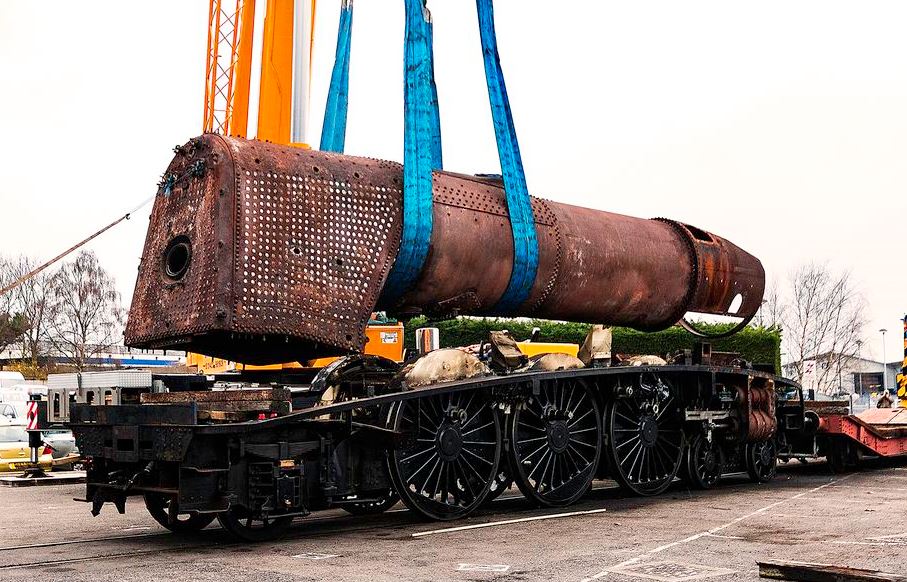
We also planned to lift out the ashpan. We thought the loco would have to be moved up to the crane however the crane had a huge reach so was just extended, picked up the ashpan and delicately placed in over the car park fence in to the North Yard.
The lift could not have gone any better. No snags or last minute work on the loco was required. The weather though dull and with some light drizzle at times was good for lifting whereas earlier in the week high winds were for forecast.
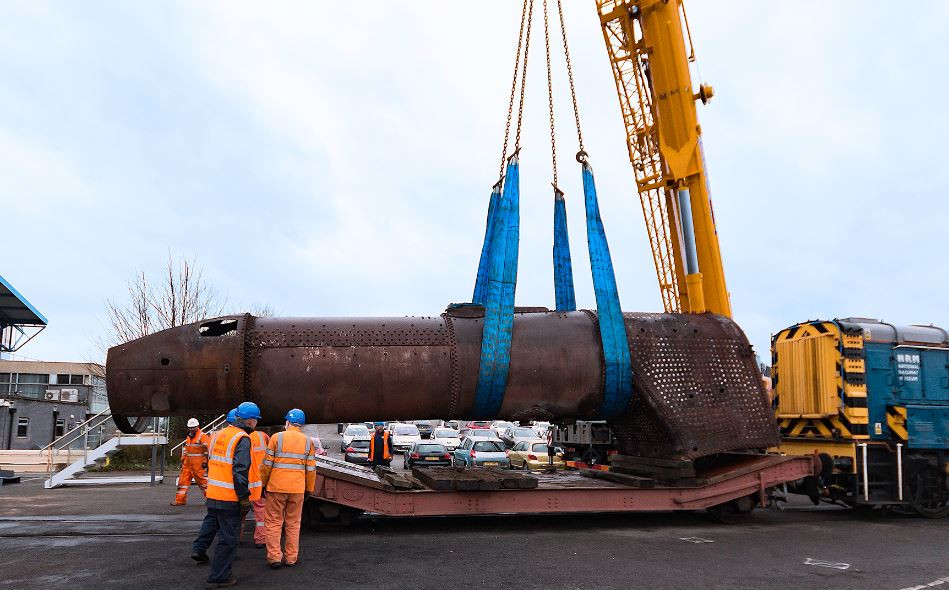
After watching the crane leave the site we took a break attended by a very relieved lifting team. We then removed the boiler bottom door and sheeted the boiler over to keep it dry. We then moved all the tools and slings back to the workshop.
The chassis was shunted back into the North Yard. It had to be moved very slowly as there was concern that the Cartazzi, upon which there was now very little weight would ride over the rail. We did see, when first moved without the boiler one wheel lift from the rail but after that it kept all it’s wheels on the rail. One concern for the museum was that we may derail and prevent Flying Scotsman from entering the Great Hall for its own exhibition. However with careful shunting by the National Railway Museum rail ops team, everything was OK.
After being shunted a minimum distance to clear the entrance to the Great Hall and allowing Flying Scotsman to enter we were shunted into the Workshop, back under the crane to continue our work.
On Saturday the ashpan in the North Yard was sheeted and then we returned to the comfort of the workshop. The spacer to support the unladen crank axle was put in place, then a start was made in removing the driving wheel springs. The trailing 4 have now been removed.
Week commencing 28 March 2016
After the excitement of last weeks boiler lift and the interest it has aroused in the press, this week has been quiet by comparison. Before we are going to start stripping the frames we are going to clean the frames so that stripping will be a much cleaner job. All volunteers this week have been involved and results are very good. The white of the frames is now showing through, so much so that it has been difficult to photo the pipe runs due to the glare of the white painted frames. Special attention has been paid to the pipework and also around the hornstays in preparation for their removal to allow the driving wheelsets to be removed. Another task attended to in preparation for dropping the wheelsets was removal and draining of the flexible lubrication pipes from the driving axlebox under keeps.
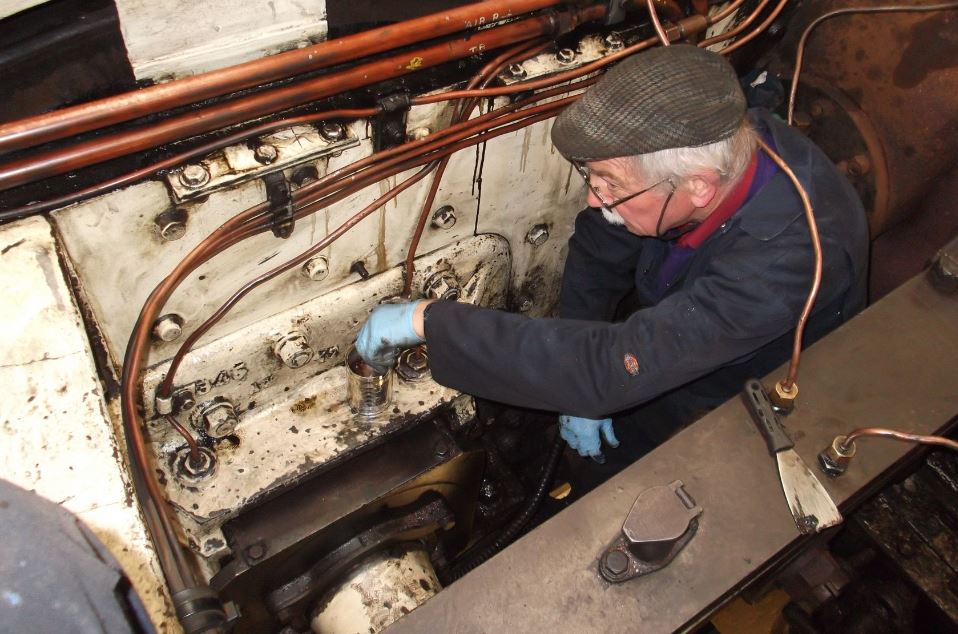
This week we completed removal of the last 2 driving springs, These were the ones on the leading drivers. These are more difficult to get off due to the proximity of the front brakeshaft. As the driving springs were removed the weight of the remaining locomotive is progressively moved onto the remaining wheelsets. So particular attention was taken of where the axleboxes of the bogie and Cartazzi were in their horns as we didn’t want to overload their springs. With all driving springs off the loco so all weight on the bogie and Cartazzi their axleboxes still show below the wear marks on the top of the horns. Even considering the removal of the boiler it shows what a considerable amount of weight has now been removed from the loco.
The previous updates can be readhere.
Thank you for interesting report and photos of work in
progress on Sir Nigel Gressley. Although I live in Huddersfield
I have an interest in NY Moors Rly. I hope to visit NRM
shortly..